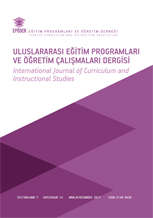The effects of using tonal and atonal chords on English sentence structure learning
Abstract
The effects of using tonal and atonal chord sequences on elementary schools students’ English sentence structure learning were examined in the present study. A total of 42 third-grade elementary school students voluntarily participated in the study. A pre-test and post-test with control group quasi-experimental design formed the design of the study. In experimental groups and control group, students were taught past tense structure during four-lesson phases. Lessons were taught through the current activities in English language lesson curriculum such as repeating and fill in the blanks in control group; whereas, in addition to these, they were taught either through a song played with atonal-chord or a song played with tonal-chord in experimental groups. Students’ learning rates regarding the sentence structure in English were assessed via the “Sentence Structure in English Multiple-Choice Test”, originally developed in the study. Findings showed that teaching the topic through a song played with atonal-chord was significantly more effective than teaching the topic both through tonal-chord version of the song and the current curricular activities only. Findings also showed that teaching English sentence structure to students through a song played with tonal-chord was not more effective than teaching the same topic through the current curricular activities only.
Downloads
References
Bancroft, W. J. (1975, May). The Lozanov language class. Paper presented at the International Symposium on Suggestology. Washington, DC, U.S.A.
Batdı, V. ve Semerci, Ç. (2012). Şarkıların yabancı dil becerilerini geliştirmedeki etkililiğine ilişkin öğrenci görüşleri. Eğitim ve Öğretim Araştırmaları Dergisi, 1(4), 15-22.
Büyüköztürk, Ş. (2007). Deneysel desenler: Öntest-sontest kontrol grubu desen ve veri analizi (2. Baskı). Ankara: Pegem.
Camerun, L. (2001). Teaching languages to young learners. Cambridge, MA: Cambridge University Press.
Cattell, R. B. (1963). Theory of fluid and crystallized intelligence: A critical experiment. Journal of Educational Psychology, 54(1), 1-22.
Cohen, J. (1988). Statistical power analysis for the behavioral sciences (2nd edition). Hillsdale, NJ: Lawrence Erlbaum.
Costa, M., Bitti, P. E. R., & Bonfiglioli, L. (2000). Psychological connotations of harmonic musical interval. Psychology of Music, 28(1), 4-22.
Cook, N. D., & Fujisawa, T. (2006). The psychophysics of harmony perception: Harmony is a threetone phenomenon. Empirical Musicology Review, 1(2), 106-126.
Deci, E. L., & Ryan, R. M., (1985). Intrinsic motivation and self-determination in human behaviour. New York, NY: Plenum.
Denk, D. (2000). Anaokuluna devam eden 6 yaş grubundaki çocukların alıcı dil gelişim düzeylerine müzik eğitiminin etkisinin incelenmesi. Yayımlanmamış yüksek lisans tezi, Hacettepe Üniversitesi, Ankara.
Dewi, N. P. (2013). Using English song memorization technique to improve the seventh graders’ mastery of vocabulary at SMP Negeri7 Malang. Master thesis, State University of Malang, Indonesia.
Eken, D. K. (1996). Ideas for using songs in the English language classroom. English Language Forum, 34(1), 46-47.
Fabon, A. B. (2013). “Take it easy”: Use songs to teach English as a second language in primary school. La Rioja: University of La Rioja Publications.
Fay, K. (2010). Connecting jazz improvisation to second language learning. 07.06.2015 tarihinde http://www.elon.edu/docs/e-web/administration/president/lumenprize/jazzarticle.pdf adresinden alınmıştır.
Fisher, D. (2001). Early language learning with and without music. Reading Horizons, 42(1), 39-49.
Fonseca-Mora, M. C., Toscano-Fuentes, C., & Wermke, K. (2011). Melodies that help: The relation between language aptitude and musical intelligence. Anglistik International Journal of English Studies, 22(1), 101-118.
Geist, K., Geist, E. A., & Kuznik, K. (2012). The patterns of music: Young children learning mathematics through beat, rhythm, and melody. Young Children, 67(1), 74-79.
Graham, C. (2011). Creating chants and songs resource books for teachers. London: OUP.
Israel, F. H. (2013). Language learning enhanced by music and song literacy. Information and Computer Education Journal, 2(1), 1269-1275.
Jacobson, N. S., & Truax, P. (1991). Clinical significance: A statistical approach to defining meaningful change in psychotherapy research. Journal of Consulting and Clinical Psychology, 59,12-19.
Jensen, E. (2000). Music with the brain in mind. San Diego, CA: The Brain Store.
Kensinger, E. A. (2007). Negative emotion enhances memory accuracy behavioral and neuroimaging evidence. Current Directions in Psychological Science, 16(4), 213-218.
Köksal, O., Yağışan N. ve Çekiç, A. (2013). The effects of music on achievement, attitude and retention in primary school English lessons. Procedia-Social and Behavioral Sciences, 93, 1897-1900.
Krumhansl, C. L. (1991). Music psychology: Tonal structures in perception and memory. Annual Review of Psychology, 42, 277-303.
Lambertz, G. D., Montavont, A., Jobert, A., Allirol, L., Dubois, J., Hertz-Pannier, L., & Dehaene, S. (2010). Language or music, mother or Mozart? Structural and environmental influences on infants’ language networks. Brain & Language, 114, 53–65.
Lenneberg, E. H. (1967). Biological foundations of language. New York, NY: John Wiley and Sons.
Levitin, D. J. (2006). This is your brain on music: Understanding a human obsession. London: Atlantic Books.
Levitin, D. J. (2014). The organized mind: Thinking straight in the age of information overload. London: Viking.
Liegeois-Chauvel, C., Peretz, I., Babai, M., Laguitton, V., & Chauvel, P. (1998). Contribution of different cortical areas in the temporal lobes to music processing. Brain, 121, 1853-1867.
Ludke, K. M., Ferreira, F., & Overy, K. (2014). Singing can facilitate foreign language learning. Memory & Cognition, 42(1), 41-52.
Mayo, M. P. G., & Lecumberri, M. L. G. (2003) (Eds.). Age and the acquisition of English as a foreign language. London: Cromwell.
Medina, S. L. (1990). The effects of music upon second language vocabulary acquisition. ERIC Document (ED 352 834).
Milli Eğitim Bakanlığı. (2013). İlköğretim kurumları (ilkokullar ve ortaokullar) İngilizce dersi öğretim programı. Ankara: Milli Eğitim Bakanlığı Talim ve Terbiye Kurulu Başkanlığı.
Modiri, I. G. (2010). Okul öncesinde müzik aracılığı ile yabancı dil öğretimi. Uludağ Üniversitesi Eğitim Fakültesi Dergisi, 23(2), 505-516.
Moon, J. (2009). The teacher factor in early foreign language learning programmes: The case of Vietnam. In M. Nikolov (ed.), the age factor and early language learning (pp. 311-336), Berlin: Mouton de Gruyter.
Moreno, S., Marques, C., Santos, A., Santos, M., Castro, S. L., & Besson, M. (2009). Musical training influences linguistic abilities in 8-year-old children: More evidence for brain plasticity. Cerebral Cortex, 19(3), 712-723.
Ogletree, E. J. (1997). Waldorf education: Theory of child development and teaching methods. ERIC Document (ED 420 418).
Pekrun, R. (2006). The control-value theory of achievement emotions: Assumptions, corollaries, and implications for educational research and practice. Educational Psychology Review, 18, 315-341. Rautenberg, I. (2015). The effects of musical training on the decoding skills of German-speaking primary school children. Journal of Research in Reading, 38(1), 1-17.
Richards J. C., & T. S. Rodgers (2002). Approaches and methods in language teaching (2nd Edition). Cambridge, MA: Cambridge University Press.
Richardson, J. T. E. (2011). Eta squared and partial eta squared as measures of effect size in educational research. Educational Research Review, 6(2), 135-147.
Salcedo, C. S. (2010). The effects of songs in the foreign language classroom on text recall, delayed text recall and involuntary mental rehearsal. Journal of College Teaching & Learning, 7(6), 19-30.
Schellenberg, E. G., Nakata, T., Hunter, P. G., & Tamoto, S. (2007). Exposure to music and cognitive performance: Tests of children and adults. Psychology of Music, 35(1), 5-19.
Sheskin, D. J. (2004). Handbook of parametric and nonparametric statistical procedures (3rd edition). New York, NY: Chapman & Hall.
Tezel, N. (2011). Akor yapısındaki tonal ve atonal ayrımlamada nörokognitif yaklaşım. Yayımlanmamış doktora tezi, Dokuz Eylül Üniversitesi, İzmir.
Zatorre, R., & Blood, A. (2001). Intensely pleasurable responses to music correlate with activity in brain regions implicated in reward and emotion. Proceedings of the National Academy of Sciences of the United States of America, 98(20), 11818-11823.





